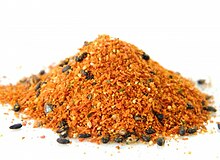 Shichimi tōgarashi. | |
| Alternative names | Nana-iro tōgarashi |
|---|---|
| Type | Spice mixture |
| Place of origin | Japan |
| Invented | 17th century |

Shichi-mi tōgarashi (七味唐辛子, seven-flavor chili pepper), also known as nana-iro tōgarashi (七色唐辛子, seven-color chili pepper)[1][2] or simply shichimi, is a common Japanese spice mixture containing seven ingredients.[3] Tōgarashi is the Japanese name for Capsicum annuum peppers, and it is this ingredient that makes shichimi spicy.[4]
Etymology[edit]
“Shichi” means seven, and “togarashi” is the red chili pepper capsicum anuum.[5] The blend is also called nanami togarashi.[5]
Ingredients[edit]
A typical blend may contain:
- coarsely ground red chili pepper (the main ingredient)
- ground sanshō ("Japanese pepper")
- roasted orange peel (Chenpi)
- black sesame seed
- white sesame seed
- hemp seed[6]
- ground ginger[3]
- nori or aonori (seaweed)
- poppy seed[5]
- yuzu peel[5]
Some recipes may substitute or supplement these with yuzu peel, rapeseed or shiso. Shichimi is distinguished from Ichi-mi tōgarashi (一味唐辛子, Ichimi, one-flavor chili pepper), which is simply ground red chili pepper.[7]
Use[edit]
The blend is traditionally used as a finishing spice. It is ubiquitous in restaurants in Japan; a shaker is sometimes on every table along with salt and pepper shakers and bottles of soy sauce.[5] It is often consumed with soups and on noodles and gyūdon. Some rice products such as rice cakes, agemochi and roasted rice crackers also use it for seasoning.[citation needed]
History[edit]

Shichimi dates back at least to the 17th century, when it was produced by herb dealers in Edo,[3] current day Tokyo, and sometimes it is referred to as Yagenbori (薬研堀, from the name of the original place of production). Most shichimi sold today come from one of three kinds, sold near temples: Yagenbori (やげん堀) sold near Sensō-ji, Shichimiya (七味家) sold near Kiyomizu-dera, and Yawataya Isogorō (八幡屋磯五郎) sold near Zenkō-ji.[citation needed]
Culture[edit]
In modern times, the product is generally sold as a formulated product, but in the past it was prepared and sold according to the customer's needs (七味唐辛子売り). Even today, performances can be seen at festival stalls.
-
This is a performance of mixing spices while explaining their benefits.
See also[edit]
References[edit]
- ^ Nihon Kokugo Daijiten (dictionary).
- ^ Shin Meikai kokugo jiten (dictionary).
- ^ a b c Zeldes, Leah A. (2010-04-14). "Eat this! Shichimi togarashi, zesty Japanese seasoning". Dining Chicago. Chicago's Restaurant & Entertainment Guide. Archived from the original on 2010-10-07. Retrieved 2010-05-22.
- ^ Gordenker, Alice, "Shichimi Togarashi: The Japanese 7-Spice Mix You Have to Try", Japanese Food Guide
- ^ a b c d e Kim, Eric (2023-10-04). "This Store-Bought Spice Blend Makes Everything Taste Better". The New York Times. ISSN 0362-4331. Retrieved 2023-10-07.
- ^ Hongo, Jun (Dec 11, 2007). "Hemp OK as rope, not as dope". The Japan Times. Retrieved 2010-05-22.
- ^ Kaneko, Amy (2007). Let's Cook Japanese Food!. Chronicle Books. p. 20. ISBN 978-0-8118-4832-9.

